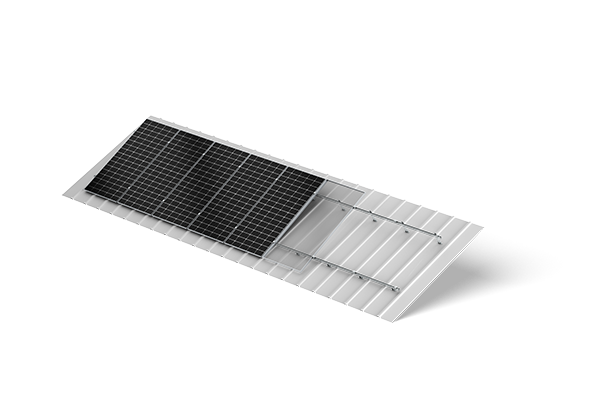Understanding Roof Pitch and Its Impact on Solar Panel Performance
August 04, 2025
When considering solar energy systems, one critical factor often overlooked is roof pitch. The angle of a roof can significantly impact the efficiency and performance of solar panels, especially when mounting solar panels to metal roof. Understanding how pitch influences solar energy production can help homeowners and businesses make informed decisions about their solar investments.

Roof pitch, defined as the ratio of the roof's vertical rise to its horizontal run, plays a crucial role in determining how much sunlight solar panels receive. In general, the ideal pitch for solar panel installation is between 30 and 45 degrees. This angle allows solar panels to capture maximum sunlight exposure throughout the day, particularly during peak hours.
Conversely, roofs with a low pitch may not provide optimal conditions for solar energy generation. When mounting solar panels to metal roofs with insufficient pitch, the panels could be less effective at capturing sunlight, particularly in winter months when the sun is lower in the sky. Understanding the relationship between roof pitch and solar performance helps maximize energy production and ensures that the investment in solar technology yields the expected returns.
In addition to pitch, the orientation of the roof also affects solar panel performance. Ideally, solar panels should face south to capture the most sunlight throughout the day. However, when combining this with roof pitch considerations, it becomes apparent that both factors must be accounted for during installation.
When mounting solar panels to metal roofs, installers must evaluate the specific pitch and orientation to determine the best layout for the solar panels. If the roof pitch is too flat or oriented incorrectly, the panels may not perform at their full potential, leading to reduced energy generation. By understanding these dynamics, solar installers can provide tailored solutions that optimize performance and efficiency.
For those utilizing metal roofs, there are specialized mounting systems available that cater to various roof pitches and types. Effective systems can enhance stability and ensure optimal angles for solar panels installed on metal roofs. These systems help address concerns related to wind resistance and overall strength, ensuring that solar panels remain securely attached while maximizing efficiency.
In summary, understanding roof pitch and its effect on solar panel performance is essential for maximizing energy output. By paying attention to the angle and orientation of metal roofs, property owners can ensure efficient energy production and derive greater benefits from their solar investments.
Antaisolar specializes in providing robust mounting solutions that address the unique challenges of installing solar panels on metal roofs. With a focus on strong stability and high efficiency, Antaisolar’s systems can help you achieve the optimal performance needed for your solar project.

The Importance of Roof Pitch
Roof pitch, defined as the ratio of the roof's vertical rise to its horizontal run, plays a crucial role in determining how much sunlight solar panels receive. In general, the ideal pitch for solar panel installation is between 30 and 45 degrees. This angle allows solar panels to capture maximum sunlight exposure throughout the day, particularly during peak hours.
Conversely, roofs with a low pitch may not provide optimal conditions for solar energy generation. When mounting solar panels to metal roofs with insufficient pitch, the panels could be less effective at capturing sunlight, particularly in winter months when the sun is lower in the sky. Understanding the relationship between roof pitch and solar performance helps maximize energy production and ensures that the investment in solar technology yields the expected returns.
Effects of Orientation and Pitch on Solar Gain
In addition to pitch, the orientation of the roof also affects solar panel performance. Ideally, solar panels should face south to capture the most sunlight throughout the day. However, when combining this with roof pitch considerations, it becomes apparent that both factors must be accounted for during installation.
When mounting solar panels to metal roofs, installers must evaluate the specific pitch and orientation to determine the best layout for the solar panels. If the roof pitch is too flat or oriented incorrectly, the panels may not perform at their full potential, leading to reduced energy generation. By understanding these dynamics, solar installers can provide tailored solutions that optimize performance and efficiency.
Optimal Solutions for Metal Roofs
For those utilizing metal roofs, there are specialized mounting systems available that cater to various roof pitches and types. Effective systems can enhance stability and ensure optimal angles for solar panels installed on metal roofs. These systems help address concerns related to wind resistance and overall strength, ensuring that solar panels remain securely attached while maximizing efficiency.
Conclusion
In summary, understanding roof pitch and its effect on solar panel performance is essential for maximizing energy output. By paying attention to the angle and orientation of metal roofs, property owners can ensure efficient energy production and derive greater benefits from their solar investments.
Antaisolar specializes in providing robust mounting solutions that address the unique challenges of installing solar panels on metal roofs. With a focus on strong stability and high efficiency, Antaisolar’s systems can help you achieve the optimal performance needed for your solar project.
end
